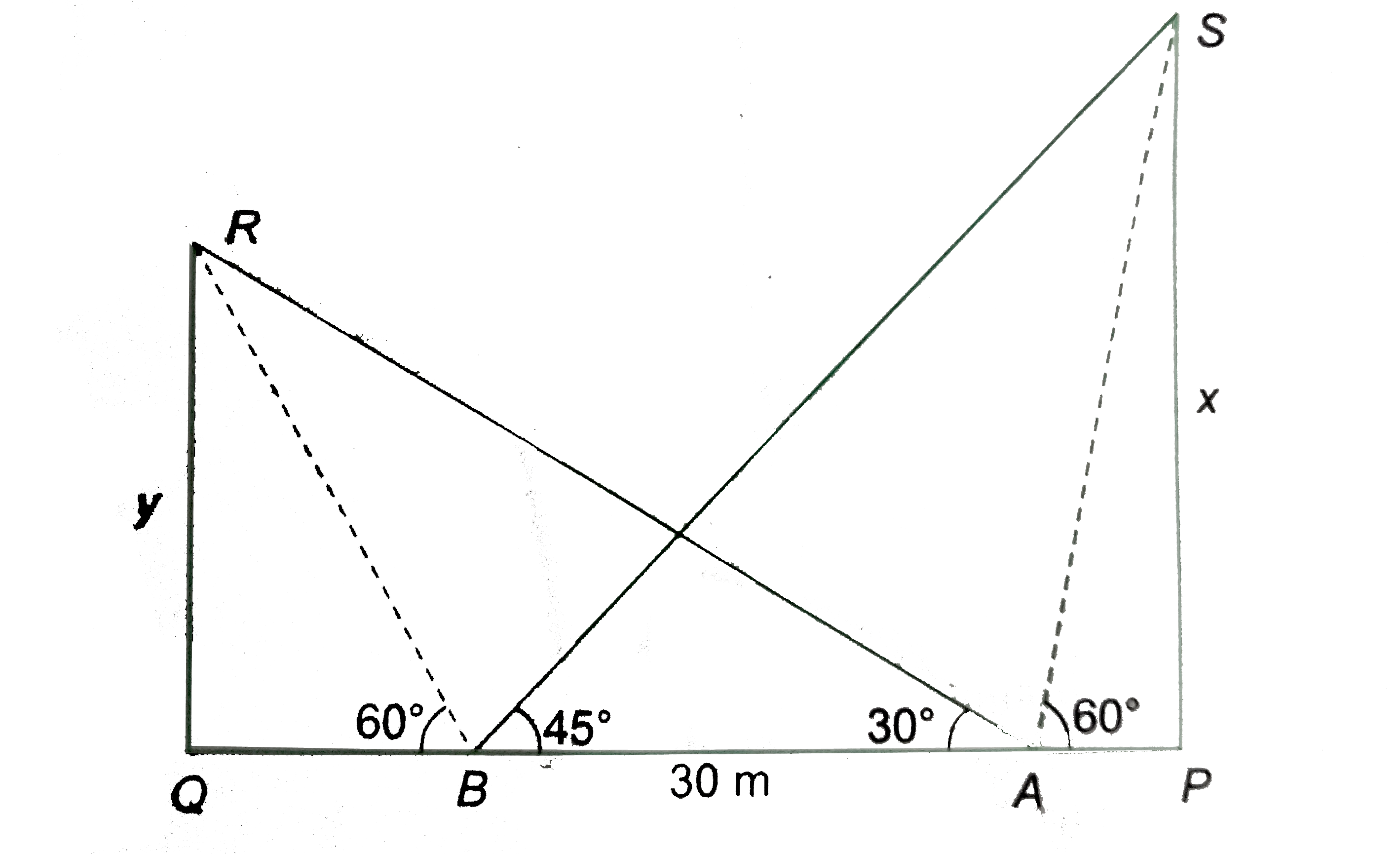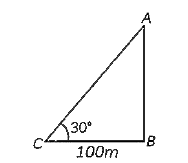Two hagstaffs stand on a horizontal plane. A and B are two points on the line joining their feet and between them. The angles of elevation of the tops of the flagstaffs as seen from A are 30∘ and60∘ and as seen from B are 60∘and 45∘. If AB is 30 m, then the distance between the flagstaffs is
30+15√3
45+15√3
60−15√3
60+15√3
The correct Answer is:D
Let x and y be the hight of the flagstaffs at P and Q respectively.

Then AP=xcot60∘=x√3
AQ=ycot30∘=y√3
BP=xcot45∘=x
and BQ=ycot60∘=y√3
∴AB=BP−AP=x−x√3
⇒30√3=(√3−1)x
⇒x=15(3+√3)
Similarly,30=y(√3−1√3)or y=15√3
∴PQ=BP+BQ=x+y√3
=15(3+√3)+15
=(60+15√3)m
Topper's Solved these Questions
- BOOK - CENGAGECHAPTER - HIGHT AND DISTANCE EXERCISE - JEE Previous Year3videos
HIGHT AND DISTANCE
- BOOK - CENGAGECHAPTER - HIGHT AND DISTANCE EXERCISE - JEE Previous Year3videos
HIGHT AND DISTANCE
- BOOK - CENGAGECHAPTER - GRAPHS OF TRIGONOMETRIC FUNCTIONSEXERCISE - Exercise22videos
GRAPHS OF TRIGONOMETRIC FUNCTIONS
- BOOK - CENGAGECHAPTER - HYPERBOLAEXERCISE - JEE Advanced Previous Year14videos
HYPERBOLA
Similar Questions
Two towers stand on a horizontal plane. P and Q where PQ = 30 m, are two points on the line joining their feet. As seen from P the angle of elevation of the tops of the towers are 30 and 60 but as seen from Q are 60 and 45. The distance between the towers is equal to
View SolutionA vertical flagstaff stands on a horizontal plane. From a point 100 m from its foot, the angle of elevation the its top is 30°. Find the height of the flqgstaf.
 View Solution
View Solution
Knowledge Check
- Question 1 - Select One
Two flagstaffs stand on a horizontal plane. A and B are two points on the line joining their feet and between them. The angle of elevation of the tops of the flagstaffs as seen from A are 30∘and60∘ and as seen from B are 60∘and45∘. If AB is 30 m, the distance between the flagstaffs in metre is
A30+15√3B45+15√3C60−15√3D60+15√3 - Question 2 - Select One
Two flagstaffs stand on a horizontal plane. A and B are two points on the line joining their feet and between them. The angles of elevation of the tops of the flagstaffs as seen from A are 30° and 60° and as seen from B are 60" and 45°. If AB is 30m, the distance between the flagstaffs in metres is
A3+15√3B45+15√3C60−15√3D60+15√3 - Question 3 - Select One
Two towers stand on a horizontal plane. P and Q where PQ = 30 m, are two points on the line joining their feet. As seen from P the angle of elevation of the tops of the towers are 30 and 60 but as seen from Q are 60 and 45. The distance between the towers is equal to
A30+15√3B45+15√3C60−15√3D60+15√3
A vertical flagstaff stands on a horizontal plane. From a point 100 m from its foot, the angle of elevation of its top is found to be 45∘. Find the height of the flagstaff.
View SolutionThe angles of elevation of the top of a tower 30 m. High, from two points on the level ground on its opposite sides are 45&∘ and 60∘. what is the distance between the two points?
View SolutionA flagstaff of length l is fixed on the top of a tower of height h. The angles of elevation of the top and bottom of the flagstaff at a point on the ground are 60∘ and 30∘ respectively. Then
View SolutionThe angles of depression of two points from the top of the tower are 30∘and60∘. IF the height of the tower is 30 m, then find the maximum possible distance between the two points.
View SolutionP is point on the segment joining the feet of two vertical poles of heights a and b. The angles of elevation of the tops of the poles from P are45∘each. Then, the square of the distance between the tops of the poles is
View Solution

